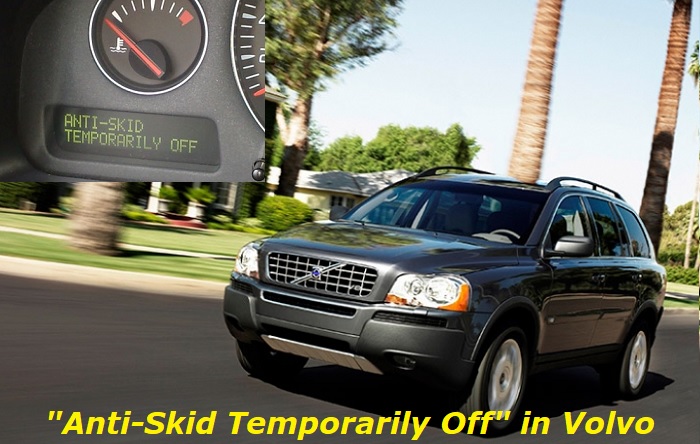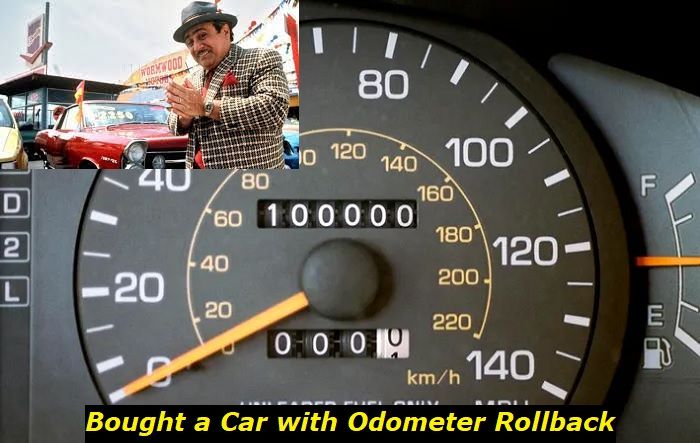Is your Volvo flashing an annoying "Anti-skid temporarily off" message? This article aims to help you understand the various problems that could cause your ESC light to flash. It will also discuss viable solutions to each of the difficulties mentioned. If the Electronic Stability Control (ESC) or Anti Braking System (ABS) light is illuminated in your Volvo,
Anti-skid temporarily off message highlights
- Common reasons:issues in stability control functions, sensors, control modules
- How to fix:read the codes,disconnect the battery for some time
- Possible consequences:vehicle's behavior may change
- Priority level:High
- Can you drive?Carefully
- DIY repair:Impossible
- Repair price range:$200-$650

What Does Anti-Skid Temporarily Off Mean?
The warning could be attempting to highlight special issues (most of which are explained below). The most common cause of this warning is the low battery supply to the DTSC and ABS systems, which causes them to shut down temporarily. This message is most likely to display after your ignition has been running for a considerable time.
Your ESC light will display as a car ahead of a pair of curly lines representing a loss of traction or skidding. If your ESC system activates as you brake, you will likely hear a throbbing sound. Your Volvo is also likely to accelerate slower than usual even when you press your pedal to the metal.
What to do When Your Anti-Skid Light Comes On
When your anti-skid light comes on, it is advisable to park in a safe spot and turn off your ignition. You can troubleshoot your Volvo by restarting the car to check whether a soft reset will turn off the ABS light. Next, check whether your dashboard offers a more detailed message or error code, which will help specify the cause of the problem.
If the cause of the problem is not obvious, it may be necessary to visit a qualified auto repair expert for a professional diagnosis and recommendation. To better understand the issues that plague your ECS system, it is important to understand its function fully.
The Function of your ESC system
Volvo did not intend for ESC to handle complex road, weather, and traffic situations. It is a supplementary system that facilitates your driving and makes it safer. You should not rely on the ESC system in place of your driver's ed skills, judgment, and attention. Ultimately, it is your responsibility to ensure your Volvo is driven safely by considering all traffic rules especially speed limits, and keeping a safe distance from other vehicles.
Your ESC system is equipped to supplement these aspects:
- Corner Traction Control - allows you to accelerate faster than usual on bends without suffering wheelspin on your inner wheel when you understeer.
- Spin control - decreases engine power whenever the drive wheels are skidding against the road or underlying surface.
- Active Yaw Control - checks your brake force and driving to stabilize your car.
- Traction Control System - it takes over when you drive at low speeds to transfer power from your spinning driving to one that isn't moving.
- Driver Steering Recommendation - helps you steer your car when the ABS engages or if there is reduced traction. Its primary function is to help you navigate in the right direction if your vehicle is skidding. Your DSR will engage by applying a small amount of torque that engages your steering wheel in the direction the car should be steered to restore maximum traction and stability.
- Engine Drag Control - prevents your wheels from locking involuntarily, for example, when you shift down or engine brake when in low gear on a slippery surface. It ensures that you never lose the ability to steer your car.
- Trailer Stability Assist - stabilizes your car and trailer combo should it begin to snake.
When your ESC light illuminates, it could be trying to warn you that one or a combination of these aspects is not working as envisioned.
Reasons Your ESC/ABS Light is Flashing
- Defective Wheel Speed Sensors
When there is a problem in your ESC system, faulty wheel sensors are often to blame. The ESC system works to monitor individual wheel speed sensors and adjust your brakes to compensate for any discrepancies observed. Where one of your wheel speed sensors is offline or giving erratic readings, your ESC will likely develop a problem.
Solution
Drivers are advised to confirm that every wheel speed sensor is operating correctly by connecting a scanning tool to monitor the speed readings of each sensor while driving. You can also opt to have a professional test your speed sensors for accuracy.
- Defective Steering Angle Sensor
Your steering angle sensor also has control over your ESC system. It works with your wheel speed sensors to guarantee that all wheels are spinning at the right speed for the direction and terrain you are handling.
When your sensors are damaged, faulty, or misaligned, they could detect and send inaccurate information to your car's computer. The most obvious symptom of a defective sensor is overcompensating the amount of steering necessary to move the vehicle to certain actions.
The steering angle sensor is essential to the ECS system because it keeps you safe while turning. It ensures you do not lose traction when turning because the outer wheels spin faster than the inner wheels. It is expected for the inner wheels to turn slower. Your steering angle sensor ensures that the ECS does not detect this normal occurrence as a slippage on one wheel while the other has excellent traction.
Solution
Drivers are advised to contact a certified Volvo dealership to investigate this issue because they will likely require the faulty sensor's replacement. A licensed dealer will ensure you purchase high-quality and compatible components.
- Defective Wiring/Electrical Problems
If your Volvo is not suffering from defective sensors, you likely have electrical or wiring problems. The issues are likely to arise when there is a loose or faulty connection in your wiring between the sensors and your ESC system. This problem is not very common and is likely to happen in your rear wheel speed sensors because their wiring is exposed. Ensure that you check your battery to ensure that it is not drained, causing your warning lights to illuminate.
Solution
Electrical and wiring problems that aren't complex can be quickly solved by ensuring no loose or faulty connections are triggering your ESC system. Where the issue is tough to diagnose, you are well advised to rely on professional diagnosis and recommendations.
Can I Drive with an Illuminated ESC Light?
Even though it is possible to ignore your ESC warning light and drive on, it is not advisable. Sometimes, the light could warn you about untenable driving conditions or faulty ESC components. Where your Volvo's lights flashed on and off during a drive on slippery roads, you need not be concerned because all your sensors are probably functioning correctly.
If your ECS light turns on when it shouldn't or remains illuminated all the time, you should not drive in that condition because your Volvo could be trying to warn you about untenable driving conditions. It is not advisable to ignore your ESC light because it allows you to retain stability by engaging crucial systems like your ABS.
A malfunctioning ESC could cause the brake on your individual tires, causing your brakes to pump on and off without warning. While the ESC light is unlikely to cause issues while driving, a malfunction could cause a serious accident.
Can I Simply Deactivate My ESC System to Turn Off the Light?
The ESC system is crucial to your safety, and Volvo settings do not allow drivers to deactivate it. If your light is illuminated, your best bet is to diagnose the particular issue and solve it, so the light turns off automatically. Alternatively, you could try switching your car to sports mode. This mode allows you to have a more dynamic driving experience without contending with an ESC warning light that keeps flashing.
When you select the Sport mode, your ESC system will allow larger limits for your steering wheel movements, accelerator pedal, and cornering than in the normal driving mode. Your ESC system will allow controlled skidding in your rear section to a certain limit where it intervenes and automatically stabilizes your Volvo.
If you release the accelerator pedal to stop a controlled skid, your ESC will intervene and stabilize the car.
Sport mode is also the best way to gain maximum traction if your Volvo is stuck or riding on a loose surface, e.g., deep snow or sand.
How to Select Sport Mode
Drivers looking to engage the Sport mode should use their menu from the MY CAR function. Once you select Sports mode, the icon will remain illuminated by a constant glow until you deselect or switch off your engine. When you restart your engine, your Volvo shall revert to its normal mode requiring you to reselect the Sports Mode every time you need extra traction.
How Much Will an Anti-Skid Volvo Servicing Cost?
The cost of replacing, repairing, or recalibrating your ECS components will vary greatly depending on your location and Volvo model. Motorists can expect to spend at least $100 to have an expert recalibrate their Yaw Control Sensor using VIDA.
About the authors
The CarAraC research team is composed of seasoned auto mechanics and automotive industry professionals, including individuals with advanced degrees and certifications in their field. Our team members boast prestigious credentials, reflecting their extensive knowledge and skills. These qualifications include: IMI: Institute of the Motor Industry, ASE-Certified Master Automobile Technicians; Coventry University, Graduate of MA in Automotive Journalism; Politecnico di Torino, Italy, MS Automotive Engineering; Ss. Cyril and Methodius University in Skopje, Mechanical University in Skopje; TOC Automotive College; DHA Suffa University, Department of Mechanical Engineering





Add comment